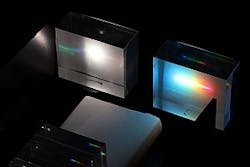PicoQuant tunable supercontinuum laser operates between 1 and 40 MHz

The Solea tunable supercontinuum laser covers the 480 to 700 nm white light spectrum, and operates at repetition rates between 1 and 40 MHz or in pulse burst pattern. Extinction between each pulse is complete, eliminating the need for contrast-limited pulse pickers. Applications include single-molecule detection and Förster resonance energy transfer (FRET).
PicoQuant
Berlin, Germany
[email protected]
More Products
-----
PRESS RELEASE
PicoQuant to present new tunable picosecond laser source at LASER World of Photonics in Munich
The recently developed supercontinuum white light laser provides variable repetition rates and external triggering capabilities
Berlin (Germany), 27 March 2013 â PicoQuant GmbH, specialist in the field of single photon counting applications, will present its recently developed tunable supercontinuum laser Solea at LASER World of PHOTONICS, held May 13 to 16, 2013 in Munich, Germany. Interested visitors will be able to see the Solea laser at booth 328, hall B1. Also on display will be a UV laser with freely adjustable repetition rates, a non-descanned detection unit with Hybrid-PMT detectors for laser scanning microscopes and further new developments.
Solea is a stand-alone, computer controlled system that can be operated at a number of user-selectable internal repetition rates or even be externally triggered at any repetition rate between 1 MHz and 40 MHz or in pulse burst pattern. The extinction between each pulse is complete, and classical, contrast limited pulse pickers are not needed. The spectrum of the white light source spans from 480 nm to 700 nm. The tunable wavelength and the flexibility in pulse triggering make the Solea an ideal excitation source for ultrasensitive applications like single-molecule detection and Förster Resonance Energy Transfer (FRET).
The UV laser LDH-P-FA-265 is a unique product that permits to generate laser pulses at 266 nm with freely adjustable repetition rates between 1 MHz and 80 MHz. The laser delivers pulse widths below 100 ps (FWHM) with average powers reaching more than 1 mW at 80 MHz repetition rate. The wavelength of 266 nm is ideally suited for label-free fluorescence measurements of molecules that contain appropriate aromatic amino acids such as tryptophan and tyrosine.
The new non-descanned detection (NDD) unit for PicoQuant's FLIM and FCS upgrade kit for laser scanning microscopes offers an excellent timing performance that permits to resolve fluorescence lifetimes down to 50 ps. This is achieved by a large core liquid light guide with high fluorescence transmission and Hybrid-PMT detectors. The fluorescence is collected very close to the objective to allow for deep tissue FLIM imaging. The high photon detection efficiency enables additional measurement modes like Fluorescence Correlation Spectroscopy (FCS). The NDD unit is available in a single or dual channel detector configuration and can be attached to both inverse and upright microscopes.
About PicoQuant
PicoQuant GmbH is a research and development company in the field of optoelectronics. The company was founded in 1996 and is based in the science and technology park Berlin-Adlershof, Germany. The company is a worldwide leader in the field of single photon counting applications. The product line includes pulsed diode lasers and LEDs, photon counting instrumentation, fluorescence lifetime spectrometers and time-resolved confocal microscopes. PicoQuant employs currently around 50 people. Since April 2008 Sales and Support in North America is handled by PicoQuant Photonics North America Inc.
-----
Follow us on Twitter
Subscribe now to Laser Focus World magazine; it's free!